This post is not implying a resemblance between the current pandemic and the perfect storm of disasters that hit Florence in the mid-1300s. Nor is it evidence for the half-assed notion that out of disaster comes good. It is only to say that sometimes beauty has deep roots. This first ran January 17, 2012.
To the left is a courtyard in the Church of the Ognissanti, All Saints, in Florence, Italy. You can’t see it in this picture, but above the little staircase, near the top of the doorway, about where the arch meets the wall, is a small sign. It’s something like the one below: In 4 November, 1966, the waters of the Arno came to this height.
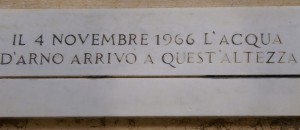
Florence is full of these signs. Most of them are from 1966, which was the most recent and worst of centuries of regular floods. They happen every 15 years or so, 56 of them since the first historic bad one in 1177. The Arno floods because the local weather swings wildly between dry and rainy and when it rains, it doesn’t stop. I was there in 2010, when it rained for 10 days straight, and while the Arno didn’t flood, for days it was ugly: it was a thick brown and fast, full of waves and whorls, making a continuous low roar. Florence is in the Arno’s floodplain, so when it does flood, it takes out the bridges, people lose their homes and businesses, ancient art and books are destroyed, people die. The flood in 1333 wasn’t the worst, but its timing was bad and for the next 15 years, Florence was visited by one disaster after another. And after disaster came the Renaissance.
In the few years before 1333, Florence was politically, culturally, and financially so rich, it had to pass sumptuary laws against too much elegance. In 1333, though, it rained for days and by November 4, the Arno had washed away three of the four bridges and part of the city wall, and filled the streets; churches were flooded up to their altars, their bells rang in prayer, and around 300 people died; it was God’s judgment on them, people said. In 1342, the government was taken over by a despot and the populace rebelled, successfully, but the succeeding governments were insecure. In 1346, the great Florentine banks, which were the girders under the Florentine and the European economies, had lent a kingdom’s worth of money to Edward III of England for a war, and when Edward lost the war and defaulted on the loan, the banks collapsed and so did the economies. The same year and the following one too, the crops failed and the people who were already out of work began starving. Then in the spring of 1348, the Black Death moved into Florence and killed around 60,000 people. They died terribly and so fast, they couldn’t be mourned. They filled the church graveyards, then the newly-dug trenches around the churches; they were stowed like cargo, people said. 60,000 people was about three-fifths of the population.
I can’t quite take this in. God is angry, the government doesn’t work, the economy is wrecked, people are out of jobs, they can’t find food. And now the plague, and it infects everyone regardless. You have five co-workers, three are dead. You have five friends, three are dead. You have five people in your family, three are dead. How would the people react to that, how could they process that kind of loss?
Catastrophes are often processed through art, of course, and what with Giotto and his school, Florence was a hotbed of art. Art history books say that Florentine painting for the decades after the disasters was stiff, symbolic, and preoccupied with death. And it’s true that in the Uffizi — that one-building class in the history of art — the paintings in the next rooms after the Giotto room are hard to get through. The colors are murky; the saints and martyrs look bodyless, acquiescent, and hopeless; nothing good will come of this world.
The rooms after those, though, beginning 50 years after the plague, are one after another, a slow revelation. The art history books say that around 1400, Florence got interested in humanism, rationality, and classicism; and its economy improved enough that merchant princes and international bankers began commissioning art. But that can’t be the whole story because the art was astounding: the fourth room after Giotto, just fifty years after hopelessness, where did those paintings come from? You go to the next room and the next, and somehow with each room, the paintings get even more astounding. They’re stunning, literally. You look at them and look at them and then you notice you’re not breathing.
Would humanism and rationality have this kind of power? Hard to believe. But wouldn’t the plague have it? How long does a culture take to process great loss? I don’t know who’s studied this. I know that the children and grandchildren of the Holocaust are still haunted by human evil. My mother was a child on a tenant farm during the Great Depression, and I’m still rinsing out plastic bags and re-using them.
I’m going to make an argument here, but I’m not going to make it with words, I’m going to make it chronologically and visually. I’m using only one subject, the Annunciation, because that makes for easier comparison, and besides I’ve always loved Annunications. The argument is as follows: Florence took fear, grim death, and grief, and gradually over years created an unbounded beauty.
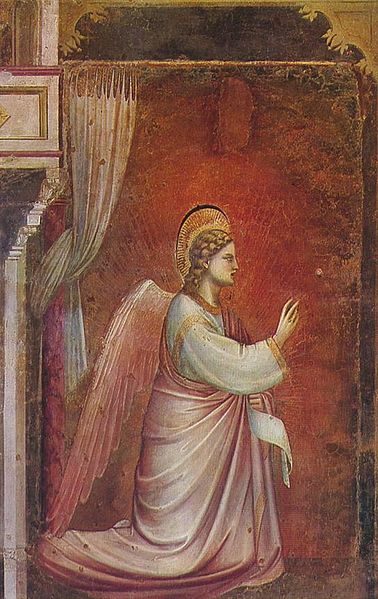
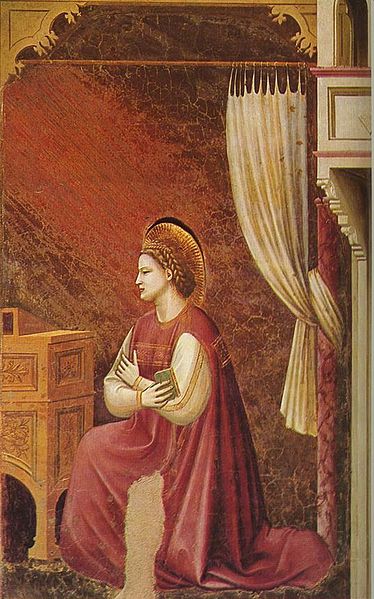
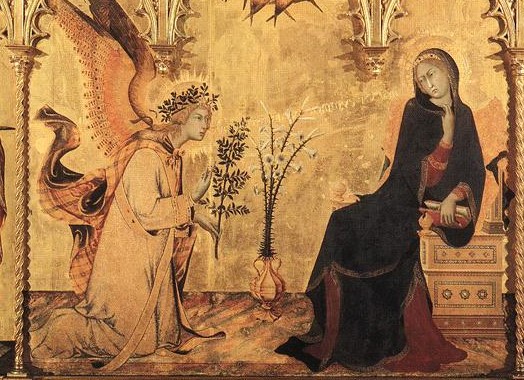
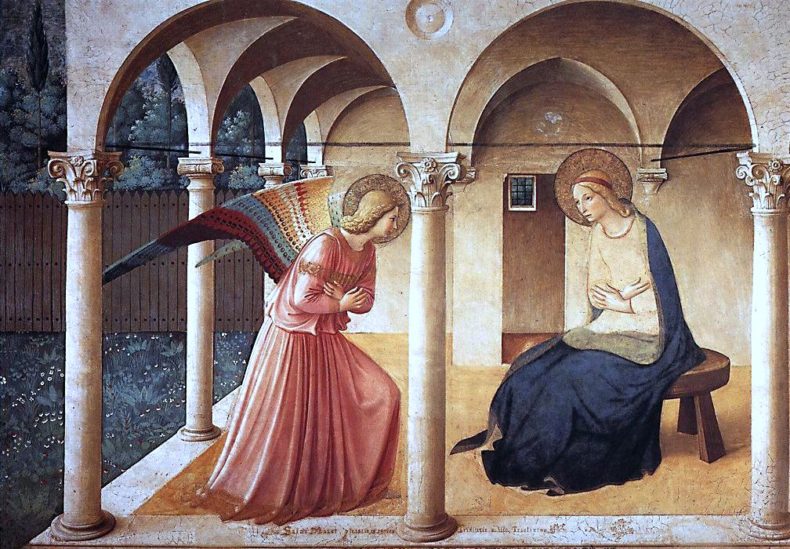
__________________
Not all these pictures are in the Uffizi. But they are all Florentine or at least Tuscan — that is, the artists were all looking at each other and at the artists earlier.
Much of this information came from four books: Florence: A Biography of a City, by Christopher Hibbert; Florence: The Golden Age, by Gene Brucker; The Art of Florence, by Glenn M. Andres, John Hunisak, & Richard Turner; and The City of Florence, by R.W.B. Lewis.
Photo credits: courtyard – me; sign – Old Fogey 1942; Annunciations – Wikimedia Commons
Wikimedia Commons, while wonderful in every way, doesn’t concern itself overmuch with accuracy in color.
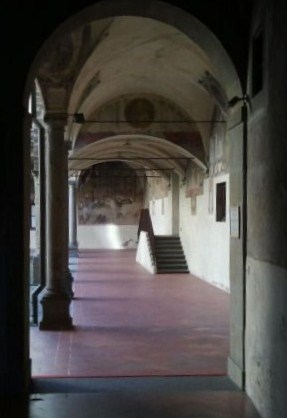
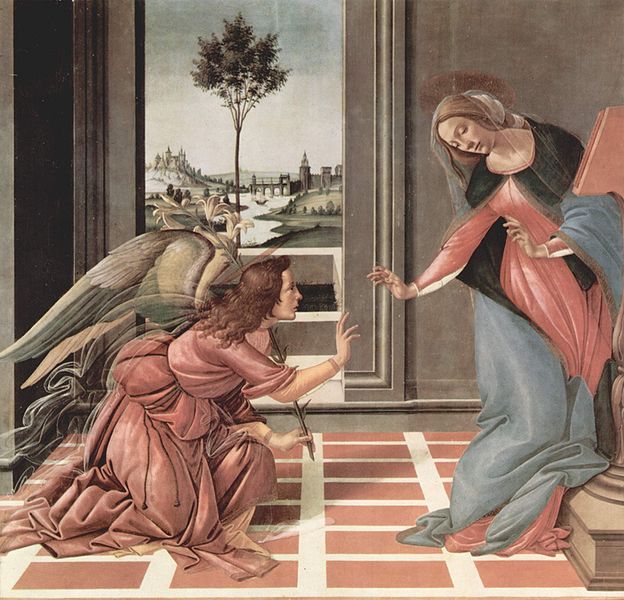
This is beautiful, Ann! Thanks for reposting this.